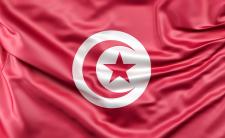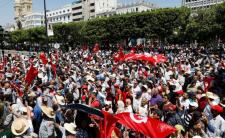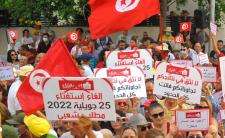Introduction
The Republic of Tunisia lies on the Mediterranean coast and shares borders with Algeria and Libya. Used as a Roman, Arab, Turk, and French trading post and regional command centre, this country covers over 160,000 square kilometres and is home to 10.6 million people. The capital of Tunis is home to nearly 800,000 people, though over 60% of the population lives in urban centres. The large majority of Tunisians are Arab Muslims, though due to its history as a former French colony, there are also European Christian and Jewish communities throughout the region as well.
Snapshot: Tunisias's Constitution making
|
|
English |
Arabic |
Commentary |
|
Constitution |
|||
|
Draft Constitution of June 2013 |
|
||
|
Draft Constitution of April 2013 |
|
||
|
Draft Constitution of December 2012 |
|
|
|
|
Draft Constitution of August 2012 |
|
|
|
|
Comparative table of drafts of August and December 2012 |
|
|
|
|
Draft Preamble May 2012 |
|
|
|
|
Draft Preamble April 2012 |
|
|
|
|
Constituent Assembly Rules of Procedure |
|
|
Constitutional History
Tunisia’s first constitutional charter can be traced back to the Fundamental Pact (1857) established by Mohamed Bey (1855-1859), following the decline of Ottoman rule over the territory in the early 19th century. The Fundamental Pact proclaimed rules governing relations between the government, the people, and foreigners in an effort to solidify his rule and placate the European powers. However, this document was replaced in 1861 with a new constitution when Muhammad as-Sadiq succeeded Mohamed Bey as the Tunisian leader. This constitution weakened the Tunisian ruler in favour of European migrants who were given property rights and guaranteed equal protection of Tunisian law. Tunisia became a French protectorate in 1881 and remained under French rule until March 1956 when it gained independence, followed by the promulgation of a new constitution on 1 June 1959.
The Constitutional Assembly drafted the 1959 Tunisian constitution in order to reinforce the rule of Habib Bourguiba, the nationalist leader who led Tunisia to independence. To achieve this, the drafters changed the Constitution of the Fourth French Republic, at the time in force in Tunisia, and reinforced executive powers. The document—amended in 1988, 2002 and 2005—also stressed the influence of Islam, placing Tunisia within the Great Arab Community and stating that that Arabic is the national language. The Constitution vested executive powers in a President elected by a direct vote for a five year term, and assisted by a Prime Minister and a Cabinet. The Prime Minister was appointed by the President, while the other members of the Cabinet were appointed by the President on the recommendation of the Prime Minister.
The legislature comprised a Chamber of Deputies and the Chamber of Advisors which was created by constitutional amendment in 2002. Deputies were elected by direct vote to a five year term. Half of the Advisors were elected from the regional and local level, one third were elected at the national level from among employers, farmers, and workers, and the remaining Advisors were appointed by the President from important national figures. Together, the two houses could, by an absolute majority, authorize the President to issue decrees and pass organic laws as specified in the Constitution. Ordinary laws were passed by a simple majority of the two houses, but were promulgated by the President.
The highest judicial authorities in Tunisia under this Constitution were the High Court and the Constitutional Council. The High Court was in charge of hearing cases related to high treason committed by government officials. The Constitutional Council had the authority of constitutional review.
Constitutional reforms in the wake of the Arab Spring
Unprecedented nationwide violent protests over unemployment, corruption, poverty, and political restrictions in 2010 after a young vegetable cart owner, Mohamed Bouazizi, set himself on fire to protest police brutality resulted in the collapse of the over 20 years old regime of President Ben Ali. General elections one year later, following an interim period of unstable successions at the helm of state resulted in the election of a Constituent Assembly to write a new Constitution. On 12 December 2011, the Constituent Assembly elected Moncef Mazourki as the Interim President. The drafting process on the new Tunisian Constitution commenced in February 2012, with considerable tension between Islamists and Secularists. The Assembly issued a first draft constitution on August 14, 2012 and a second draft on December 14, 2012. The assassination of the opposition leader, Shoukri Belaid, on February 6, 2013, briefly interrupted the drafting process. However, the process resumed and the Assembly issued a third draft on April 22, 2013. On June 1, 2013 the committee in charge of drafting the constitution finally agreed on a draft, which was submitted to the provisional legislature. After months of protests and deadlock, the draft was then passed by a two-third majority of the National Constituent Assembly and on 26, January 2014.The resulting constitution is a liberal text that states that Islam is the country's religion, while at the same time recognizing freedom of conscience and belief, and equality between the sexes.
Although Tunisia’s transition process was considered to be less tumultuous compared to Egypt’s, it was not without challenges. Agreeing on the kind of political regime for instance proved to be a contentious issue at all stages. There was on the one hand the Ennahda Movement pushing for a parliamentary system with a Prime Minister based on the German or British model and on the other, political parties like the Congress for the Republic and the Progressive Democratic Party, pushing for a French style semi-presidential system. Additionally, the Islamic political parties sought to have the constitution declare Islam as the main source of legislation. Ennahda had to make broad concessions like dropping its earlier goal of establishing Tunisia as an Islamic state and declaring the supremacy of Sharia law.
The 2014 Constitution
Executive branch
The 2014 Constitution provides for a semi presidential system along the French model, but with the difference that the Prime Minister, who is appointed from Parliament, by the President, but in consultation with the latter, will be significantly more powerful. The Prime Minister appoints all government minsters except those for defence and foreign affairs. The President has exclusive control over these two ministries. The Prime Minister presides over the administration and negotiates international agreements of technical nature. The Council of Ministers meet on convocation by the Prime Minister, who fixes the agenda. Overall executive authority is exercised by the President of the Republic who is the Head of State, representing its unity, securing its independence and continuity.
The President of the Republic is elected by general, free, secret and direct elections.
Legislative branch
Legislative power is vested in a single Assembly of Representatives. Members are elected by universal suffrage for a term of five years. Members enjoy parliamentary immunity but are subject to arrest in case of a flagrant delicto. Voting in the assembly is personal and may not be delegated. The assembly can through the initiative of a majority of its members vote to impeach the President for grave violations against the Constitution
Judicial branch
The judiciary is divided into four branches. Firstly, there is the ordinary judiciary headed by a Supreme Court (Cassation) which deals with criminal and civil appeals from lower courts falling within this branch. Next is the administrative judiciary consisting of administrative courts and tribunals dealing with all administrative cases with appeals lying from there to the Supreme Administrative Court. Then, there is the financial judiciary comprising a special Court of Audit for financial matters. Lastly, there is the Constitutional Court with jurisdiction over constitutional disputes. The Constitutional Court is composed of 12 members having no less than 15 years of high expertise, two thirds of whom must be legal specialists. The President of the Republic, the Speaker of the Chamber of Deputies, the Prime Minister, and the Supreme Judicial Council shall each nominate six candidates, two thirds of who must be legal specialists. Judges enjoy statutory criminal immunity unless this is lifted. Other auxiliary bodies of the judicial branch include a Supreme Judicial Council which manages the profession of judges and the State Counsel.
System of Government under 2014 Constitution
Timeline
| 1600s | Ottoman Turks conquer Tunisia |
| 1857 | Mohamed Bey creates the Fundamental Pact addressing relations between the ruler, the people, and the foreigners |
| 1861 | Muhammad as-Sadiq promulgates Tunisia’s first constitution that increased the rights of Europeans |
| 1878 | Congress of Berlin confirms French supremacy over Tunisia |
| 1881 | French invade Tunisia which becomes a French protectorate |
| 1934 | Pro-independence Neo-Destour Party founded by Habib Bourguiba |
| 20 March 1956 | France recognizes Tunisia’s independence, Bourguiba named first President |
| 1 June 1959 | President Bourguiba promulgates new constitution |
| 1974 | Constitutional amendment names Bourguiba President for Life |
| 1981 | Ban on opposition parties lifted |
| November 1987 | Bourguiba replaced by Sine el Abidine Ben Ali in bloodless coup in which Bourguiba is declared too senile to rule |
| 1988 | Constitutional amendment limits the President to three five year terms |
| 1994 | Constitutional amendment opens representation in the legislature to opposition parties |
| April 2000 | Bourguiba dies |
| May 2002 | Referendum approves constitutional changes allowing President Ben Ali to run for additional terms and creating the upper house of the legislature, the Chamber of Advisors |
| August 2005 | The Chamber of Advisors holds its inaugural session |
| 2008 | Constitutional amendments allow multi-candidate presidential elections, reduce voting age to 18, and provide for increased election regulation |
| October 2009 | President Ben Ali wins a fifth term |
| 2010 | Nationwide popular protests erupt over unemployment, corruption, poverty, and political restrictions, leading to violent government repression |
| January 2011 |
President Ben Ali forced into exile as popular protests continue |
| February 2011 |
Protesters calls for a clean break from the past resulting in the resignation of Prime Minister Mohamed Ghannouchi |
| October 23, 2011 |
Parliamentary elections held and Ennahda Islamist party wins more seats than any other party but does not get a majority |
| December 2011 |
Moncef Marzouki elected President by the constituent assembly and Ennahda leader Hamadi Jebali sworn in as Prime Minister |
| 14 August 2012 |
NCA issues first draft constitution |
| August 2012 |
Protest over a draft constitution referring to women as “complementary to men”. |
| 14 December 2012 |
NCA issues second draft constitution. |
| 6 February 2013 |
Assassination of the secular opposition leader, Shoukri Belaid. |
| 22 April 2013 |
NCA issues third draft of constitution. |
|
1 June 2013 |
Committee drafting the constitution submits the fourth and final draft to the NCA for a vote. |
| January 27, 2014 |
Tunisia Assembly approves new Constitution. |
Bibliography
Chritian Caryl, Can Tunisia Save the Arab Spring, Foreign Policy, (June 7, 2013), http://www.foreignpolicy.com/articles/2013/06/07/can_tunisia_save_the_arab_spring.
Christopher Walker and Vanessa Tucker, Tunisia: The Arab Spring's Pivotal Democratic Example, Freedom House, http://www.freedomhouse.org/article/tunisia-arab-springs-pivotal-democratic-example (last visited June 18, 2013).
Constitution of Tunisia." University of Richmond Constitution Finder. Web. 29 Jun 2011.<http://confinder.richmond.edu/admin/docs/Tunisiaconstitution.pdf>.
Duncan Pickard, The Politics of Tunisia’s Final Draft Constitution, Atlantic Council, (May 15, 2013) http://www.acus.org/viewpoint/politics-tunisia%E2%80%99s-final-draft-constitution.
Edward Cody, Tunisia Faces Political Struggle Over Islam, Washington Post, http://www.washingtonpost.com/world/tunisia-faces-political-struggle-over-islam/2013/06/16/1000670a-cdef-11e2-8845-d970ccb04497_story.html (last visited June 19, 2013).
George Sadek, The Role of Islamic Law in Tunisia’s Constitution and Legislation Post-Arab Spring, Library of Congress, (May 2013), http://www.loc.gov/law/help/Tunisia_2013-009164_final_rpt.pdf.
Maddex, Robert L. Constitutions of the World. 3rd ed. Washington, D.C.: CQ Press, 2008. Print.
Jörg Fedtke, Tunisian Constitutional Reform and Decentralization: Reactions to the Draft Constitution of the Republic of Tunisia, International IDEA and The Center for Constitutional Transitions at NYU Law, (June 2013), http://www.constitutionnet.org/files/3_fedtke_decentralization.pdf.
“Tunisia Draft Constitution” (Unofficial English Translation), April 22, 2013, http://constitutionaltransitions.org/wp-content/uploads/2013/05/Tunisia-third-draft-Constitution-22-April-2013.pdf.
Sujit Choudhry & Richard Stacey, Semi-Presidentialism as a Form of Government: Lessons for Tunisia, International IDEA and The Center for Constitutional Transitions at NYU Law, (June 2013), http://www.constitutionnet.org/files/2_choudhry_stacey_separation_of_powers.pdf.
United States. CIA World Factbook: Tunisia. , 2011. Web. 29 Jun 2011. <https://www.cia.gov/library/publications/the-world-factbook/geos/ts.html>.
United States Department of State. Background Note: Tunisia. , 2010. Web. 29 Jun 2011. <http://www.state.gov/r/pa/ei/bgn/5439.htm>.
| Branch | Hierarchy | Appointment | Powers | Removal |
|---|





